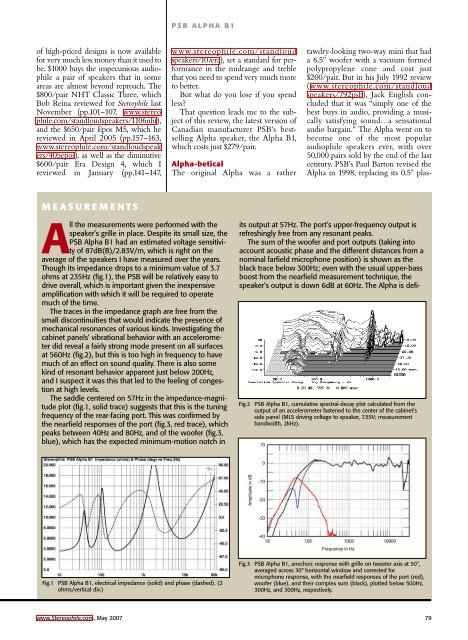home entertainment 2007
home entertainment 2007
home entertainment 2007
Create successful ePaper yourself
Turn your PDF publications into a flip-book with our unique Google optimized e-Paper software.
of high-priced designs is now available<br />
for very much less money than it used to<br />
be. $1000 buys the impecunious audiophile<br />
a pair of speakers that in some<br />
areas are almost beyond reproach. The<br />
$800/pair NHT Classic Three, which<br />
Bob Reina reviewed for Stereophile last<br />
November (pp.101–107, www.stereo<br />
phile.com/standloudspeakers/1106nht),<br />
and the $650/pair Epos M5, which he<br />
reviewed in April 2005 (pp.157–163,<br />
www.stereophile.com/standloudspeak<br />
ers/405epos), as well as the diminutive<br />
$600/pair Era Design 4, which I<br />
reviewed in January (pp.141–147,<br />
MEASUREMENTS<br />
PSB ALPHA B1<br />
All the measurements were performed with the<br />
speaker’s grille in place. Despite its small size, the<br />
PSB Alpha B1 had an estimated voltage sensitivity<br />
of 87dB(B)/2.83V/m, which is right on the<br />
average of the speakers I have measured over the years.<br />
Though its impedance drops to a minimum value of 3.7<br />
ohms at 235Hz (fig.1), the PSB will be relatively easy to<br />
drive overall, which is important given the inexpensive<br />
amplification with which it will be required to operate<br />
much of the time.<br />
The traces in the impedance graph are free from the<br />
small discontinuities that would indicate the presence of<br />
mechanical resonances of various kinds. Investigating the<br />
cabinet panels’ vibrational behavior with an accelerometer<br />
did reveal a fairly strong mode present on all surfaces<br />
at 560Hz (fig.2), but this is too high in frequency to have<br />
much of an effect on sound quality. There is also some<br />
kind of resonant behavior apparent just below 200Hz,<br />
and I suspect it was this that led to the feeling of congestion<br />
at high levels.<br />
The saddle centered on 57Hz in the impedance-magnitude<br />
plot (fig.1, solid trace) suggests that this is the tuning<br />
frequency of the rear-facing port. This was confirmed by<br />
the nearfield responses of the port (fig.3, red trace), which<br />
peaks between 40Hz and 80Hz, and of the woofer (fig.3,<br />
blue), which has the expected minimum-motion notch in<br />
Fig.1 PSB Alpha B1, electrical impedance (solid) and phase (dashed). (2<br />
ohms/vertical div.)<br />
www.stereophile.com/standloud<br />
speakers/107era), set a standard for performance<br />
in the midrange and treble<br />
that you need to spend very much more<br />
to better.<br />
But what do you lose if you spend<br />
less?<br />
That question leads me to the subject<br />
of this review, the latest version of<br />
Canadian manufacturer PSB’s bestselling<br />
Alpha speaker, the Alpha B1,<br />
which costs just $279/pair.<br />
Alpha-betical<br />
The original Alpha was a rather<br />
tawdry-looking two-way mini that had<br />
a 6.5" woofer with a vacuum formed<br />
polypropylene cone and cost just<br />
$200/pair. But in his July 1992 review<br />
(www.stereophile.com/standloud<br />
speakers/792psb), Jack English concluded<br />
that it was “simply one of the<br />
best buys in audio, providing a musically<br />
satisfying sound…a sensational<br />
audio bargain.” The Alpha went on to<br />
become one of the most popular<br />
audiophile speakers ever, with over<br />
50,000 pairs sold by the end of the last<br />
century. PSB’s Paul Barton revised the<br />
Alpha in 1998, replacing its 0.5" plas-<br />
its output at 57Hz. The port’s upper-frequency output is<br />
refreshingly free from any resonant peaks.<br />
The sum of the woofer and port outputs (taking into<br />
account acoustic phase and the different distances from a<br />
nominal farfield microphone position) is shown as the<br />
black trace below 300Hz; even with the usual upper-bass<br />
boost from the nearfield measurement technique, the<br />
speaker’s output is down 6dB at 60Hz. The Alpha is defi-<br />
Fig.2 PSB Alpha B1, cumulative spectral-decay plot calculated from the<br />
output of an accelerometer fastened to the center of the cabinet’s<br />
side panel (MLS driving voltage to speaker, 7.55V; measurement<br />
bandwidth, 2kHz).<br />
Fig.3 PSB Alpha B1, anechoic response with grille on tweeter axis at 50",<br />
averaged across 30° horizontal window and corrected for<br />
microphone response, with the nearfield responses of the port (red),<br />
woofer (blue), and their complex sum (black), plotted below 500Hz,<br />
300Hz, and 300Hz, respectively.<br />
www.Stereophile.com, May <strong>2007</strong> 79

















